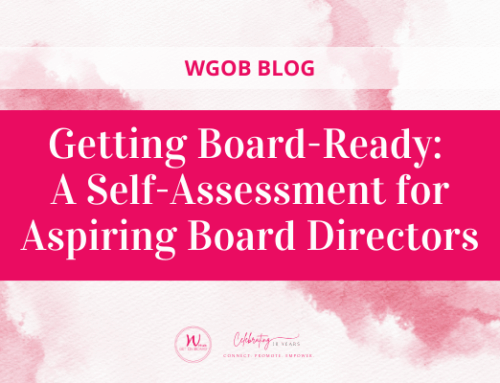Women Get On Board Inc. (WGOB) is a member-based company that connects, promotes and empowers women to corporate boards.
On December 12, WGOB hosted the third part their virtual WGOB Speaker Series on ESG, sponsored by UBS. The fireside chat focused on the “G” of ESG—governance issues.
To begin the event, Deborah Rosati, FCPA, FCA, ICD.D, GCB.D, Corporate Director and WGOB Founder and CEO, introduced Aneliya Crawford, Managing Director at UBS Investment Bank and leader of UBS’s ESG Advisory Group efforts for the Americas.
Then, Aneliya welcomed Ivy Lumia, CEO and Founder of Best in Governance Inc. (BIG), a boutique firm with global reach that specializes in providing modern, sustainable corporate governance and ESG frameworks for boards and executive teams.
What is the “G” in ESG?
Ivy and Aneliya opened the conversation by discussing the modern definition of the “G” in ESG. Although boards have always focused on governance, Ivy explained that the meaning of the term has evolved in recent years to reflect new issues and technologies.
“When a company is looking at governance through the lens of the ‘G’ in ESG, they are encompassing more than traditional governance concerns,” she said.
Now, when we talk about governance, we must include discussions of social purpose, ethical issues, sustainability, diversity and inclusion, privacy and stakeholder engagement. Additionally, traditional governance topics are changing, from risk to procurement to executive compensation. These changes in the world of governance reflect the new realities of the corporate landscape as we look ahead to the future.
To illustrate the way emerging issues are shaping the future of governance, Ivy raised the example of AI chatbots such as ChatGPT, which can emulate human-generated writing with impressive accuracy. Such technologies are just one of the many emerging issues that must be factored into modern governance decisions.
What framework should boards use to tackle governance issues?
Because there is no single universal governance framework for ESG, tackling these issues can feel intimidating for board leaders.
“It’s daunting, because governance now encompasses so many things,” said Ivy.
However, there are plenty of frameworks available that companies can use as a starting point for their ESG strategies. Ivy recommended identifying a model that fits your industry as well as the specific needs of your stakeholders, drawing on models used by similar organizations who have seen success in this area. Ultimately, boards should determine their governance framework and best practices based on what suits their board, needs, business practices and organizational culture.
To evaluate your company’s ESG framework as a board leader, start with a few basic questions. Does it support the vision, values, purpose and long-term strategy of the company? Does it consider people, operations, resources and stakeholder commitments? Does it identify clear targets and meaningfully address them? And—possibly most important—is there a mechanism to properly govern the strategy?
ESG strategic plans can be developed using a methodology similar to how companies build their corporate strategy. It should be built by the board of directors and supported by executive management, using the organization’s mission and social purpose as a guide. Once the strategy is established, leaders should kickstart conversations about ESG across the company—first with employees, and then with external stakeholders.
Strong stakeholder engagement is key. To effectively implement any strategic plan, it’s critical for everyone to have the same understanding of the relevant issues and the company’s ESG goals.
Why should board directors take action on ESG issues?
As Aneliya pointed out throughout the conversation, many executives are still not convinced that it is necessary to pay attention to or act on ESG issues. So why is it important that board directors bring them to the boardroom table?
Simply put, it’s part of your fiduciary duty. As a board member, you are responsible for acting in the best interests of the company and its stakeholders—and understanding and addressing the broader impact of ESG issues is an important piece of that. ESG issues carry legal, reputational, and financial risks to companies that cannot be ignored. To fulfill their responsibilities, board directors must respond to these issues with thought and foresight.
Increasingly, there is also pressure from stakeholders for companies to be proactive on ESG.
“Investors are taking these issues into account more and more in their decisions,” said Aneliya.
Who should boards be accountable to on ESG?
Aneliya also raised another common concern around ESG—the perceived business costs. Many executives worry that acting in the interest of an environmental or social purpose will negatively impact the bottom line.
Ivy’s response? There is no need to choose between returns for shareholders and ESG, because they go hand-in-hand.
“The business case for ESG has been made over and over again,” said Ivy.
Executing a strong ESG strategy has been shown to improve stock prices, provide access to new capital, differentiate entities, create new value propositions, and even usher in new partnership opportunities. Rather than diminish the performance of the company, better environmental, social, and governance outcomes have been proven to lead to better business outcomes.
What does the future of governance look like?
Ivy and Aneliya both predict that ESG issues will continue to grow in importance over the coming years.
“As awareness of environmental, social and governance issues continues to grow, shareholders and stakeholders are going to increasingly expect that companies implement some kind of ESG strategy,” said Ivy.
This prediction applies not only to public companies, which are currently leading the charge on ESG, but also private companies and crown corporations, which will be expected to follow suit. Understanding the direction that the corporate world is headed, it’s more critical than ever for board leaders to understand how to create, enact and evaluate effective ESG strategy moving forward.






